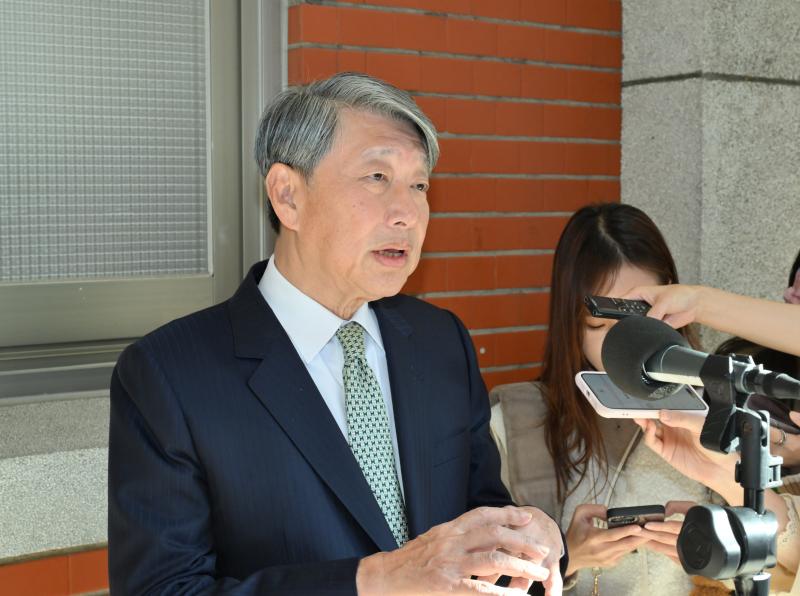US president-elect Donald Trump’s planned tariffs on products from Canada, Mexico and China would most affect Taiwan’s electronic manufacturing services (EMS) industry, although the impact would be minimal, Minister of Economic Affairs J.W. Kuo (郭智輝) said today.
Trump during his campaign vowed to sharply increase tariffs on all Chinese imports if re-elected.

Photo: Tien Yu-hua, Taipei Times
Yesterday, he announced plans to levy 25 percent tariffs on imports from Canada and Mexico and an additional 10 percent tariff on products from China, on top of existing tariffs.
The announcement raised concern about its effect on Taiwanese electronic manufacturing companies with factories in Mexico, including Hon Hai Precision Industry Co, Wistron Corp, Quanta Computer Inc, Compal Electronics Inc, Inventec Corp and Pegatron Corp.
Kuo today addressed a meeting of the Economics Committee at the Legislative Yuan and responded to questions.
Before the meeting, he told reporters that information had only just become available yesterday about Trump’s proposed tariff hikes.
The Ministry of Economic Affairs has not yet consulted expert opinions, but plans to hold joint discussions with industry leaders to find an appropriate response, he said.
Initial estimations predict that the new tariffs would most impact the EMS industry, Kuo said.
EMS refers to companies that design, manufacture, test, distribute and repair electronic components.
However, the majority of EMS infrastructure is located in the US states of Texas and New Mexico, Kuo said.
Industry experts would have to develop new strategies and response measures, but otherwise, the proposed tariffs would not have too great of an effect on the industry, he added.

The Coast Guard Administration (CGA) and Chunghwa Telecom yesterday confirmed that an international undersea cable near Keelung Harbor had been cut by a Chinese ship, the Shunxin-39, a freighter registered in Cameroon. Chunghwa Telecom said the cable had its own backup equipment, and the incident would not affect telecommunications within Taiwan. The CGA said it dispatched a ship under its first fleet after receiving word of the incident and located the Shunxin-39 7 nautical miles (13km) north of Yehliu (野柳) at about 4:40pm on Friday. The CGA demanded that the Shunxin-39 return to seas closer to Keelung Harbor for investigation over the

National Kaohsiung University of Science and Technology (NKUST) yesterday promised it would increase oversight of use of Chinese in course materials, following a social media outcry over instances of simplified Chinese characters being used, including in a final exam. People on Threads wrote that simplified Chinese characters were used on a final exam and in a textbook for a translation course at the university, while the business card of a professor bore the words: “Taiwan Province, China.” Photographs of the exam, the textbook and the business card were posted with the comments. NKUST said that other members of the faculty did not see

The Taipei City Government yesterday said contractors organizing its New Year’s Eve celebrations would be held responsible after a jumbo screen played a Beijing-ran television channel near the event’s end. An image showing China Central Television (CCTV) Channel 3 being displayed was posted on the social media platform Threads, sparking an outcry on the Internet over Beijing’s alleged political infiltration of the municipal government. A Taipei Department of Information and Tourism spokesman said event workers had made a “grave mistake” and that the Television Broadcasts Satellite (TVBS) group had the contract to operate the screens. The city would apply contractual penalties on TVBS

A new board game set against the backdrop of armed conflict around Taiwan is to be released next month, amid renewed threats from Beijing, inviting players to participate in an imaginary Chinese invasion 20 years from now. China has ramped up military activity close to Taiwan in the past few years, including massing naval forces around the nation. The game, titled 2045, tasks players with navigating the troubles of war using colorful action cards and role-playing as characters involved in operations 10 days before a fictional Chinese invasion of Taiwan. That includes members of the armed forces, Chinese sleeper agents and pro-China politicians